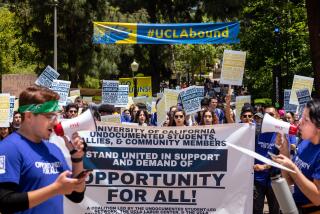Hopeful Aliens Seek Key to Residency : Lines Form for English Classes
It was a scene that is being repeated hundreds of times as the start of the fall semester arrives at Californiaâs colleges: students lining up to enroll in classes. But the nearly 1,000 people waiting in line at Rancho Santiago College on Tuesday knew that they had no choice about which class to take.
They were there to sign up for the English class each of them must complete in order to satisfy the federal requirements for permanent residency status under the Simpson-Rodino immigration reform bill, passed by Congress and signed into law by President Reagan in November, 1986.
For illegal immigrants seeking amnesty, the stakes are high, and some prospective students began lining up at 11 the night before to be first in line when the doors opened at 7:30 a.m. Tuesday. They were there hoping to get one of the 900 spaces available in various levels of English-as-a-second-language (ESL) courses being offered this fall at the Centennial Education Center of the community college in Santa Ana.
âThe people are so anxious. Itâs never been this bad,â said Irene Salcido, a college registrar who was registering students.
The collegeâs ESL enrollment has increased 13% since the amnesty program began last year, according to John S. Nixon, Rancho Santiagoâs assistant dean of continuing education.
ESL enrollment was at capacity during the spring and summer semesters, Nixon said, adding that the college will undoubtedly reach its 14,000-student capacity for the program during the fall semester. That number includes students who attend classes at the collegeâs 50 sites throughout Orange and Santa Ana, some of them local high schools, elementary schools and churches at which evening classes are offered.
The amnesty law requires applicants to obtain an âaffidavit of satisfactory pursuit,â which community colleges and adult schools confer on students when they have successfully completed at least 30 hours of instruction in an English course approved by the Immigration and Naturalization Service. An approved course must include some U.S. government and history instruction.
In Orange County, an estimated 130,000 illegal immigrants entered the first phase of the amnesty program by applying for residency. In the second phase, the INS requires that applicants show a proficiency in English and a knowledge of U.S. civics and history. That requirement can be satisfied either through an exam or by the minimum 30-hour attendance at a class such as the ones offered at Rancho Santiago.
Most of those enrolling Tuesday were from Mexico and other Latin American countries, Salcido said. Many were new students needing to enroll in beginning English classes. Others of those waiting in line Tuesday morning have lived in the United States for several years and learned to speak some English but now are required to take the course to become legal residents.
Once the applicants reached the registration window, those that spoke some English were given an oral or written test to help registrars such as Salcido place them in one of the seven different levels of ESL classes.
âWhatâs your name,â Salcido asked one young, dark-haired man. He replied but was unable to answer the next questions. âWhat country are you from?â He just shook his head no. âWhat time is it now?â Another shake of the head and a quick smile.
âHe needs the beginning class,â Salcido observed, handing him some papers. âBut thereâs just no room.â Popular morning and evening classes filled up quickly, and more than 100 applicantsâ names were placed on waiting lists. The drop-out rate in the ESL classes is high, Nixon noted, and those on waiting lists will be asked to register again as other students drop out.
In some parts of Orange County, however, the supply of ESL classes far exceeds the number of applicants. âThe demand for these classes is up for most of the county . . . ,â Nixon said. âHowever, last week some agencies such as those in the (Irvine and Costa Mesa) area were geared up for their (ESL) adult education courses, but the students were not arriving. The point is some adult programs in Irvine are not seeing the (large) enrollment we are in Santa Ana.â
It is, Nixon noted, a matter of demographics: The demand for ESL classes is obviously going to be greater where the people who need them live.
âThese applicants really arenât that mobile either,â Nixon said. âTheyâll go to another neighborhood, maybe, but not to another city.â
By 1 p.m. Tuesday, Dionicio Espinoza, a 37-year-old truck driver, was almost to the door of the registration building. He had been waiting since 5:30 a.m. Espinoza moved to the United States from Mexico 13 years ago.
âThatâs a long time Iâve been away, but I want to speak English fluently,â said Espinoza, a truck driver and Santa Ana resident.
Others, such as Santa Ana residents Maurirlia Salazar, 18; Maria Quintero, 23, and Camelia Calderon, 23, sat underneath the hot August sun Tuesday afternoon still waiting to receive numbers for their places in line.
Calderon said she had moved to Santa Ana from Mexico seven years ago.
âMy family was poor and I needed to work,â she said.
She and her friends had taken an English class during the spring semester, but now they must take the INS-approved class that includes history and government in order to pass the amnesty requirements.
âI need (English) in my work, for work in the restaurant,â said Calderon, who works in Costa Mesa.
Aside from gaining permanent residency, Calderon said she wanted to learn English to be able to continue her education in the United States.
âI was a student in Mexico, but my family didnât have the money for my schooling,â Calderon said.
The long line Tuesday in Santa Ana symbolizes a developing problem that may threaten the amnesty program in parts of California. âThere are just not enough of what are called qualified teachers that can handle the numbers of people through the present facilities in the public institutions,â said Harold Ezell, the western regional commissioner for the INS.
Orange County figures were not available, but in Los Angeles, school districts can accommodate about 300,000 amnesty applicants. But according to Ezell, there are 875,000 who need to take the course.
More to Read
Sign up for Essential California
The most important California stories and recommendations in your inbox every morning.
You may occasionally receive promotional content from the Los Angeles Times.










